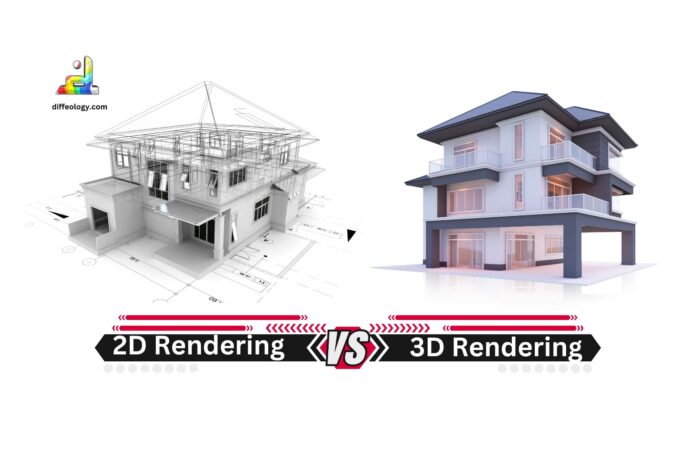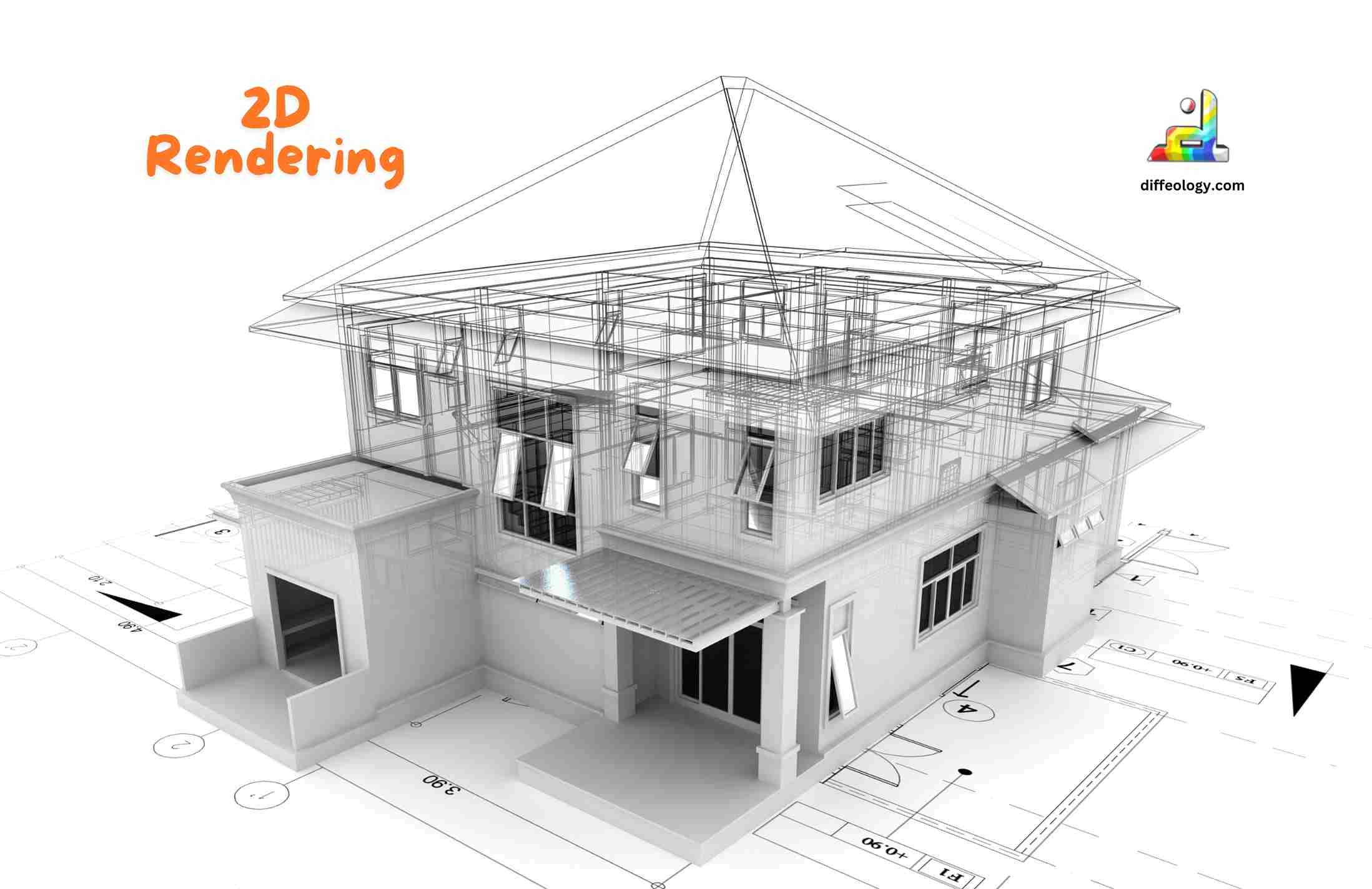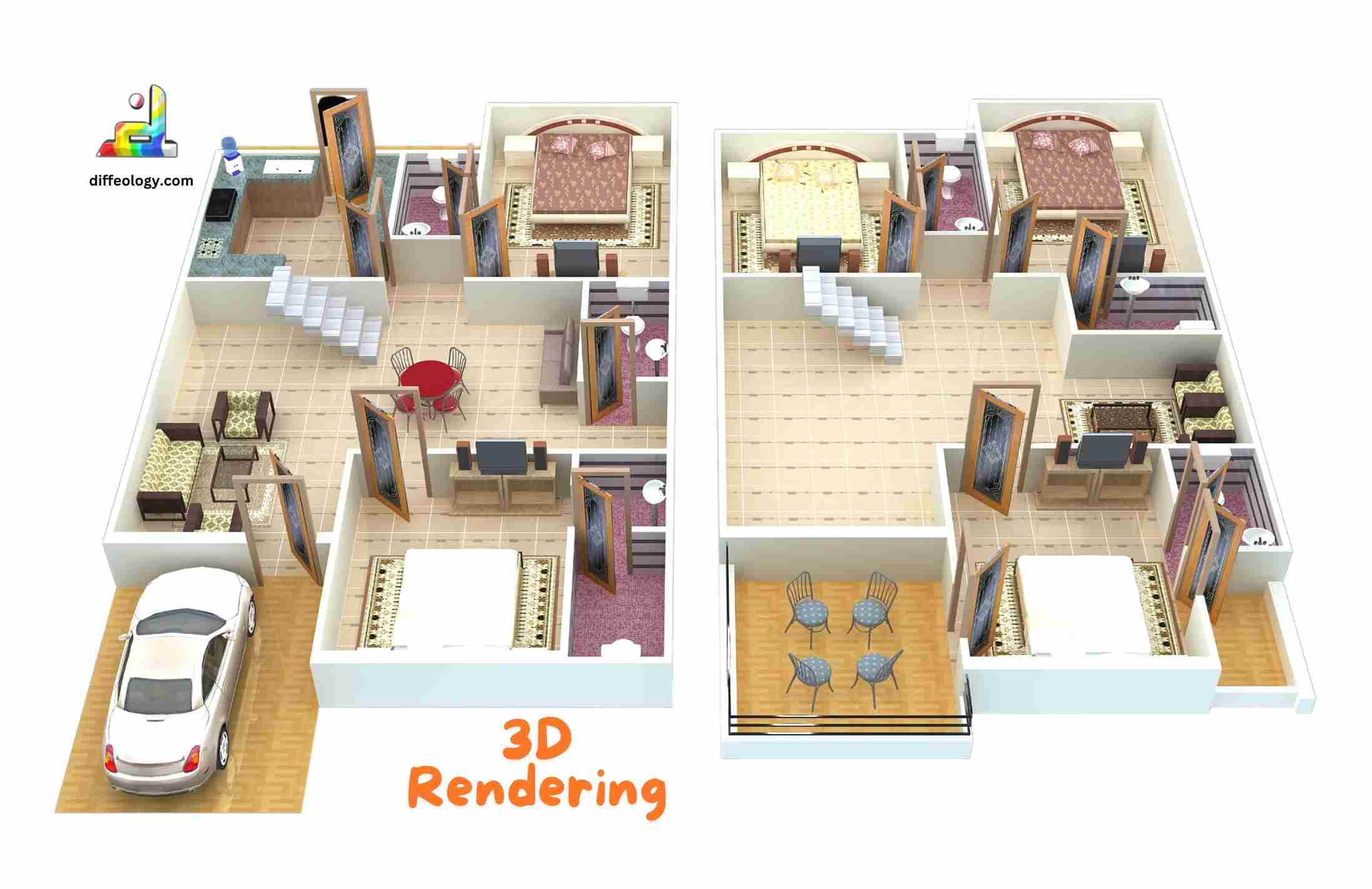Do you know the Difference Between 2d and 3d Rendering. Imagine watching your favorite cartoon on TV or playing a video game with amazing graphics. Have you ever wondered how these images are made? Well, that’s where 2D and 3D rendering come into play. In simple terms, 2D rendering is like drawing pictures on a piece of paper using a computer, while 3D rendering is like bringing your toys to life in a game or a movie. 2D rendering creates flat images, like cartoons or illustrations, with just height and width, while 3D rendering adds depth to images, making them look more realistic, like in real life. Both types of rendering are essential in creating the visual effects we see in movies, games, and even architectural designs.
Main Difference Between 2d and 3d Rendering
2D rendering is often associated with traditional artistic styles like cartoons and illustrations, while 3D rendering offers a broader range of styles and aesthetics. 3D rendering files tend to be larger due to the complexity of the models and textures, while 2D rendering files are generally smaller and more manageable. To run 3D-rendered content smoothly, more powerful hardware, such as dedicated graphics cards, is often required, whereas 2D rendering can run on less powerful devices.
2D Vs. 3D Rendering
What is 2D Rendering?
2D rendering is like taking a picture of something you draw on paper, but instead of using a camera, a computer does it. Imagine you draw a cute cartoon character on your computer, and you want to see it on the screen just like you drew it. That’s where rendering comes in. It’s the process of turning that drawing into something the computer can show you on the screen. So, when you play a video game with colorful graphics or watch an animated movie, all those pictures you see are created through rendering.
Read Also: Difference Between 2D and 3D Movies
The computer takes the information about the drawings, colors, and shapes and turns it into a picture that you can see and interact with on the screen. It’s like magic! Rendering helps make everything on your screen look real or fun, depending on what you’re looking at. Just like how you use different colors and shapes to make your drawings look cool, computers use special programs to make everything look amazing on your screen.
What is 3D Rendering?
3D rendering is like bringing your favorite toys to life in a video game or a movie. Imagine you have a cool toy car, and you want to see it race around in a game or movie. That’s where 3D rendering comes in. It’s the process of turning those toys, or 3D models, into pictures that look real or fantastic on the screen. So, when you watch a movie with amazing special effects or play a video game with realistic graphics, all those cool images are created through 3D rendering.
Read Also: Difference Between Flat and Apartment
The computer takes the information about the toy cars, buildings, or characters and turns it into pictures that you can see and even interact with on the screen. It’s like making magic happen! Just like how you can imagine different adventures for your toys, 3D rendering helps create all kinds of adventures and stories in movies, video games, and even virtual reality experiences. It’s what makes everything look so awesome and fun on your screen.
Comparison Table “2D Rendering Vs. 3D Rendering”
| Definition | Shows objects with two dimensions, like drawings or photos | Displays objects with three dimensions, like in real life |
| Depth | Flat images with only length and width | Has depth, with length, width, and height |
| Examples | Cartoons, paintings, photographs | Movies with realistic effects, 3D games |
| Complexity | Simpler, no need for depth perception | More complex, creates realistic depth and perspective |
| Tools | Uses 2D software like Adobe Photoshop | Uses 3D software like Blender, Autodesk Maya |
| Realism | Limited realism, flat appearance | High realism, lifelike appearance |
| Applications | Graphic design, illustration | Animation, visual effects, architectural visualization |
| Interactivity | Limited interactivity, static images | High interactivity, dynamic scenes |
| Depth Perception | No depth perception required | Requires understanding of depth and perspective |
| Rendering Techniques | Uses rasterization or vector graphics techniques | Employs techniques like ray tracing, global illumination |
| Image Complexity | Handles simpler images with fewer details | Handles complex images with intricate details |
| Resource Intensity | Requires less computational power | Demands more computational power for complex calculations |
| Output | 2D images, like on paper or screens | 2D images and 3D models, suitable for various platforms |
| Visual Impact | Limited visual impact, suitable for certain purposes | High visual impact, suitable for immersive experiences |
| Learning Curve | Easier to learn for beginners | Steeper learning curve, requires understanding of 3D space |
| Production Efficiency | Faster production process | Slower production process due to complexity |
Difference Between 2D and 3D Rendering in Detail
1. Dimensionality:
2D rendering involves using sprites, which are flat images placed on a two-dimensional plane, like drawing on a piece of paper. On the other hand, 3D rendering employs three-dimensional models that have depth and perspective, mimicking how objects appear in the real world. This difference fundamentally affects how visuals are represented in games and animations, with 3D rendering offering a more immersive experience due to its realistic depiction of depth and space.
2. Movement and Interaction:
In 2D rendering, movement is typically restricted to simple up, down, left, and right motions, occasionally incorporating diagonal movements. This limitation stems from the two-dimensional nature of the visuals. Conversely, 3D rendering allows for more complex movement and interaction, enabling characters and objects to move freely in three-dimensional space, offering a more dynamic and realistic gameplay experience.
3. Asset Complexity:
2D assets are relatively simpler compared to their 3D counterparts. In 2D rendering, assets are usually created as flat images or sprites, requiring less computational power and storage space. On the contrary, 3D assets are more complex as they involve modeling three-dimensional objects with textures, materials, and animations, demanding higher processing capabilities and memory resources. This complexity contributes to the enhanced visual fidelity and realism achievable in 3D rendering.
4. Depth Perception:
One significant difference between 2D vs 3D rendering is depth perception. In 2D rendering, depth is simulated through techniques like parallax scrolling, where objects closer to the viewer move faster than those farther away, creating an illusion of depth. However, in 3D rendering, depth perception is inherent due to the use of perspective projection, allowing objects to have accurate depth representation based on their distance from the viewer, resulting in a more realistic visual experience.
5. Camera Control:
2D rendering typically employs a fixed camera perspective, where the view remains constant throughout the game or animation. In contrast, 3D rendering offers dynamic camera control, allowing players or viewers to manipulate the camera angle and perspective, providing a more immersive and interactive experience. This flexibility enhances gameplay and storytelling by enabling unique viewpoints and cinematic effects.
6. Realism and Immersion:
3D rendering often provides a higher level of realism and immersion compared to 2D rendering. With advanced lighting, shading, and physics simulations, 3D environments and characters can closely resemble real-world counterparts, allowing for deeper engagement and emotional connection with the content. This realism is especially crucial in modern video games and films, where lifelike visuals contribute to the overall experience and narrative impact.
7. Development Complexity:
Developing a 3D-rendered game or animation typically requires more time, resources, and expertise compared to creating a 2D-rendered counterpart. The process of modeling, texturing, rigging, and animating three-dimensional assets is inherently more complex and labor-intensive, demanding specialized skills and software tools. Additionally, optimizing performance and ensuring compatibility across various platforms can pose additional challenges in 3D development. However, the rewards of delivering immersive, visually stunning experiences often justify the investment in 3D rendering technology.
Key Difference Between 2d and 3d Rendering
- Dimensionality: In 2D rendering, everything appears flat, like a drawing on paper, while in 3D rendering, objects have depth and can be viewed from different angles, making them look more lifelike.
- Visual Complexity: 2D rendering involves simpler visuals, often using sprites or images, whereas 3D rendering can create intricate environments and characters with detailed textures and lighting effects.
- Movement: 2D rendering typically allows movement along two axes (up-down, left-right), while 3D rendering enables movement in three-dimensional space, adding more freedom and realism to animations and games.
- Camera Perspective: In 2D rendering, the camera perspective is fixed, while in 3D rendering, the camera can move dynamically, allowing players or viewers to explore environments from different angles.
- Realism: 3D rendering offers greater realism by simulating lighting, shadows, and reflections realistically, making scenes appear more natural compared to the flat look of 2D rendering.
- Development Tools: Different tools are used for 2D and 3D rendering. For 2D, software like Adobe Photoshop or Illustrator is commonly used, while 3D rendering requires specialized software such as Blender or Autodesk Maya.
- Processing Power: 3D rendering demands more processing power and memory compared to 2D rendering, as it involves complex calculations to create realistic three-dimensional scenes.
- Depth Perception: 2D rendering simulates depth using techniques like layering, while 3D rendering naturally incorporates depth perception, allowing viewers to perceive distance and scale more accurately.
- Asset Creation: Creating assets for 3D rendering involves modeling, texturing, and animating three-dimensional objects, which is more time-consuming and intricate than creating 2D assets like sprites or images.
- Interactivity: 3D rendering often enables more interactive experiences, allowing users to interact with objects in the environment in a more immersive way compared to 2D rendering.
FAQs: 2D Vs. 3D Rendering
Conclusion:
In conclusion, understanding the difference between 2D and 3D rendering helps us appreciate the magic behind the images we see on screens. While 2D rendering is simpler and more artistic, 3D rendering adds depth and realism, making images come to life. Whether it’s watching your favorite cartoon or exploring a virtual world in a video game, both 2D and 3D rendering play a crucial role in creating the visual experiences we enjoy. So, next time you watch a movie or play a game, remember the incredible work that goes into rendering those amazing images in both 2D and 3D. It’s like bringing imagination to life!
References & External Links
- What are the Different Types of 3D Rendering Services?



